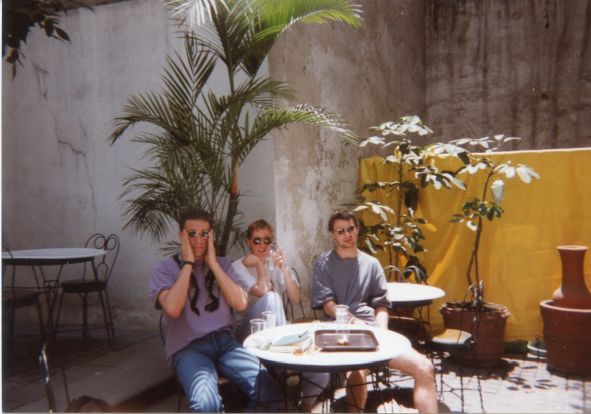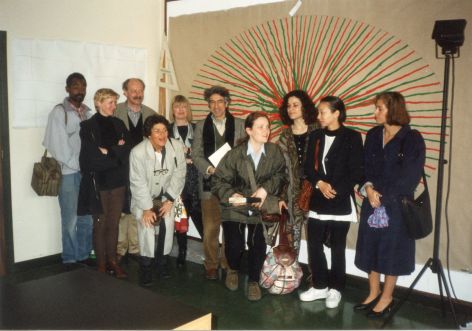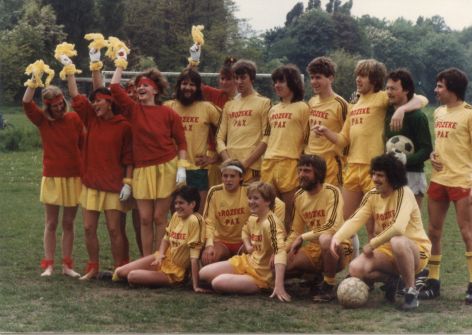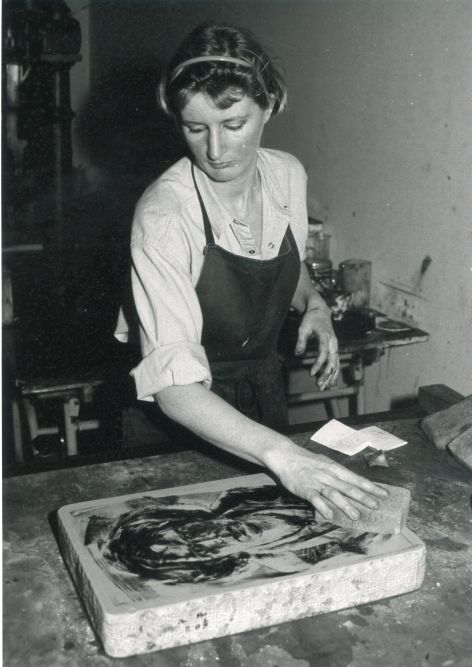“This generation of students is more assertive and not afraid to speak up”. Experienced alumna and employer Els Van den Eynden has seen so much change since her own years at the Academy. After 37 years of work, she is saying goodbye to her trusted workplace in the Mutsaardstraat and we don’t want to let that go by without notice . Why is the art college so close to her heart? You find out below.
- You graduated from the Academy in 1983 with a degree in Free Graphics. How were those college years?
“The Academy then cannot be compared to today. There was a certain discipline involved, but what I remember most is the freedom we had and embraced wholeheartedly. We worked extremely hard and gave the best of ourselves in the workshops and during the theory courses. That was also expected of us. Were you not on time for drawing class? Then you could get a serious scolding. But there was also a lot of space to party and enjoy life together. We were a real family. I sometimes miss that group feeling among the students. ”
“The teaching assignment was smaller then, 12 hours a week, so barely 2 days to supervise us. In general, I think that the lessons then were a bit more diverse and broader than now. We were taught World Literature, could study a foreign language in a language lab or could choose grime as an elective, for example. More attention was also paid to international perspectives. Think of the course Non-European Art History, where African and Asian art was discussed. As icing on the cake, our enthusiastic teachers would take us to Paris and Berlin where we got to know art outside Western Europe in a great number of museums.”
- What stands out most when you compare our current students with what you were like as a student?
“I mainly come into contact with master's students. They are very focused on their artistic work and less on theoretical subjects. It is striking that they learn to present their work better to a (hypothetical) audience and that that the importance of a good portfolio receives more attention. This generation of students is more assertive and not afraid to speak up. The student council is a good example of this. If they want to organize or change something in the Academy, they make themselves heard. I think that skill is a big help when they take their first steps in a real working environment as a newly graduated designer or artist.”
- What moment of your student years have stayed with you?
“Drawing figures together with teachers and students from the higher and lower years of the Free Graphics studio was particularly inspiring. I learned a lot from that. I will also not forget the knowledge gained from my fellow students. ‘The Tamarind Book of Lithography’ was our Bible then and luckily for me, they read very fluently and I was able to benefit from what they learned from it.”
“Something the academy was fantastic at was organizing balls. These parties were grand and simply fantastic. They continued into the early hours, often ending only when the sun was once again visible in the sky, announcing a new day. We were not painters, sculptors or jewelry designers at that time, but simply students of the Academy. Students who liked to throw parties.”
- Did you go to work right away?
“Like many alumni of the Academy, I worked briefly in the hospitality industry here in Antwerp after graduating. Then I went on welfare for a short time, which at the time meant that you had to queue every day to get a stamp as proof of unemployment. In between, I took a figure drawing course at the Academy of Mechelen once or twice a week.”
- How did you end up at the National Higher Institute of Fine Arts (NHISK for short)?
“In 1985 my former teacher of lithography, Wim van Remortel, asked me if I wanted to become an assistant in the Free Graphics studio. This was at the National Higher Institute of Fine Arts, which was then still part of the Antwerp Academy. I never dared dream about a job at the Academy and certainly not at the NHISK, so I didn't hesitate for a second. I was able to start full-time right away.”
“The first years at the NHISK, I trained at the Rhok in Etterbeek, Brussels, under Rudolf Broulim, Czech master lithographer, to master lithography down to the last detail. It was a fantastic and educational experience.”
- What exactly did your position at NHISK entail?
“My first assignment was to set up the graphics studio because the training of the Academy and NHISK was kept separate. I assisted the students during the printing process, provided materials in the studio and assisted teachers during their lessons.”
“Under the then director of the NHISK, Gerard Gaudaen, the program was expanded. Guest lecturers were invited, so visits had to be planned and trips organized. I was therefore brought in to coordinate all NHISKers, then about 50 artists. I thought it was wonderful to steer those novelties in the right direction with the necessary freedom.”
“In 1995 a major revolution took place. Due to the imminent merger of schools that offer a 2nd degree to Hogescholen, the NHISK as part of the Academy lost its right to exist and became an independent non-profit organization with the name HISK. The studios moved from the Mutsaardstraat to the Isabellalei, eventually ending up at the military site in Lange Leemstraat. It felt like pure anarchy. In the beginning, the daily operations relied on only a few employees and a small number of permanent teachers such as Dirk Braeckman and Philip Aguirre. There was a director, one person who took up all the secretarial work, someone in charge of accounting and a third person for technical support. My task was to act as an intermediary for the 'candidate laureates' (the students), guest lecturers and the board. Very quickly the most important part of the program consisted of many visits by guest lecturers from the Netherlands and abroad. Names such as Catherine David, David Elliott, Marlène Dumas, Luc Tuymans, Berlinde De Bruyckere, Wim Delvoye and even Delphine Boël came by the school. Not only artists but also curators, art theorists and gallerists visited the young artists in their studio.”
“Apart from planning the individual visits of the guest lecturers to the candidate laureates, there were also the exhibitions on the site itself, the organization of trips to exhibitions at home and abroad - such as the Venice Biennale and the Documenta in Kassel - the lending of materials and the division of the studios (sometimes resulting in fierce discussions).”
- How did you end up at the Academy?
“In 2003 it was announced that the HISK would move from Antwerp to Ghent. With my young family in Antwerp, I didn't feel like moving. I was seconded from the Academy which meant I was entitled to return. Since there was no immediate assignment waiting for me - I arrived in the middle of the academic year - I started helping the administration with implementing what I remember to be the first digital version of the student administration. Fortunately, I was soon able to apply my expertise from HISK in coordinating exhibitions, competitions and other events. Gradually, production became my real job.”
“I initially took on assignments that were not filled in at the time: drawing up timetables, communication, sending out newsletters, answering messages that were not education-related, safety, room management and I even worked shortly as an ombuds person, something that didn't really suit me because I had no experience or training.”
- What will you miss the most?
“I will certainly miss the work itself and my close colleagues, but I got the most satisfaction and energy from working closely with students and the result that you can enjoy afterwards. The master's exhibition, for example. There were sometimes blood, sweat and tears involved, but you always got so much in return.”
- What do you think is the importance of art in society?
“The feeling you get by seeing and experiencing something 'beautiful'. It doesn't always have to be concrete and clear, you can also look at an abstract work and be overwhelmed. But in my view it is and remains an elitist concept that cannot easily be transferred to people who have not been in contact with it in their upbringing. So there is still a way to go, even though many schools are now incorporating arts education into their curriculum.”
- Is art something you grew up with?
“On my mother's side there was definitely an artistic approach, although the focus was more on the performing arts. Stories of the local theater company's weekly gatherings at her home surfaced regularly at family gatherings. My father was a technical draftsman and knew the technique of screen printing, which he applied to small printed matter. Although it was not easy to go to museums with our family - after all, we were at home with seven children - the interest in art was certainly stimulated.”
- What does the future hold for you?
“It seems almost inconceivable to me that I will leave the Academy completely behind me. And since I have personally experienced the great need for volunteers for events, I am ready to make the work of my colleagues easier.”
“There is also the studio in the house, built to let Leo, my husband, celebrate his creativity. Big enough, so I'll find a corner. Drawing and painting together is very inspiring. This summer we felt that we should start with an artists' collective in the Documenta theme. We will see…"
“For me, art remains a good way to give emotions a place. This holiday during a family gathering a lot of old photos resurfaced. It gave me ideas. I don't know exactly how that will manifest itself, but I'm sure inspiration will strike soon!”
“For the rest, I'm going to enjoy my retirement. Traveling when our finances allow it, enjoying time with family and taking out my yoga mat every now and then. And of course I will also visit the Academy very often. In other words, I’ll be back!”

Mexico City - 1993: In this picture, you can see me together with Hugo Roelandt (sponsor of the prize with the same name, passed away in 2015) and Stef Van Doninck on a terrace in the museum Templo Mayor in Mexico City.

Parijs - 1994: André Goezu, Antwerp graphic designer who lives in Paris was guest lecturer at the NHISK for a while. Every year he took a select group of NHISKers to Paris. This picture commemorates a visit to the atelier of Filip Francis, a known painter and colleague of Hugo Heyrman and Panamarenko.

Sports day - 1982: During my student days, sporting events were occasionally organized. This photo was taken before or after a soccer match between students and teachers. Along with 3 other jewelry design students, a fellow student and myself decided to act as cheerleaders. One of the jewelry designers is Karen Hendrix, from the well-known jewelry designer duo Wouters & Hendrix.





